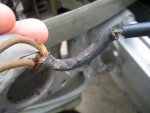Basszilla4
Seaman Apprentice
- Joined
- Jun 5, 2008
- Messages
- 44
Just installed a Faria 12 pole tachometer. F_R had kindly given me some quick instructions on installing in a different post. This is how I hooked up:
1 - Found gray signal wire in the control unit.
2 - Found purple key switch wire also in control unit.
3 - Tach has four wires on back. Red, Black, Gray, and Blue.
4 - Hooked red wire to purple wire in control. Key switch.
5 - Hooked tach gray wire to gray signal/pulse wire in control.
6 - Hooked blue wire to 12v hot on light for speedo.
7 - Hooked black tach wire to negative wire from speedo light.
All lights (speedo, tach, and fuel gauge) are hooked in sequence through a fused toggle switch. All lights work. Also, tach needle was below the "0" on the dial. Once I turned key to the on position, the needle went to the "0" position. Every time I turn key to "ON" position, the tach needle moves slightly to the "0" mark. I put my muffs on after installing and nothing. Needle doesn't move at all with engine rpm's. Tried flipping instrument light toggle switch and still nothing.
Something I am doing wrong here? Is there a way to make sure I have the "signal" going to the gray wire in control? I followed gray wire back to engine. Once it goes to big red disconnect plug on engine, I loose track of it.
My thinking is it may be how I have the ground connected on the tach itself. Just want to see if anybody has any suggestions before I start rewiring.
Any info would be greatly appreciated. Thank you.
Sincerely,
Errol (Basszilla4)
1 - Found gray signal wire in the control unit.
2 - Found purple key switch wire also in control unit.
3 - Tach has four wires on back. Red, Black, Gray, and Blue.
4 - Hooked red wire to purple wire in control. Key switch.
5 - Hooked tach gray wire to gray signal/pulse wire in control.
6 - Hooked blue wire to 12v hot on light for speedo.
7 - Hooked black tach wire to negative wire from speedo light.
All lights (speedo, tach, and fuel gauge) are hooked in sequence through a fused toggle switch. All lights work. Also, tach needle was below the "0" on the dial. Once I turned key to the on position, the needle went to the "0" position. Every time I turn key to "ON" position, the tach needle moves slightly to the "0" mark. I put my muffs on after installing and nothing. Needle doesn't move at all with engine rpm's. Tried flipping instrument light toggle switch and still nothing.
Something I am doing wrong here? Is there a way to make sure I have the "signal" going to the gray wire in control? I followed gray wire back to engine. Once it goes to big red disconnect plug on engine, I loose track of it.
My thinking is it may be how I have the ground connected on the tach itself. Just want to see if anybody has any suggestions before I start rewiring.
Any info would be greatly appreciated. Thank you.
Sincerely,
Errol (Basszilla4)




















